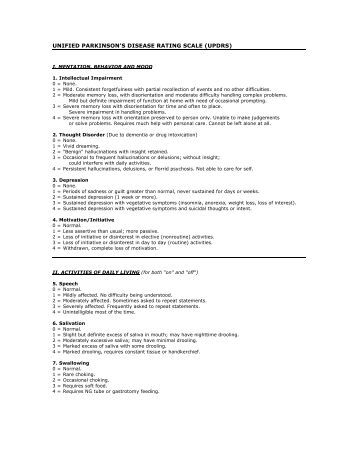
Tremor Severity Scales The Fahn-Tolosa-Marin Tremor Rating Scale The Fahn-Tolosa-Marin scale was first published in 198810 and was later revised in 1993.7 This scale con-tains sections for assessing rest, postural and kinetic/ intention tremor amplitude in specific anatomic loca-tions (part A); tremor in writing, drawing, and pour. Fahn Tolosa Marin Tremor Rating Scale Pdf; Fahn Tolosa Marin Tremor Rating Scale Pdf; Introduction Tremor is among the most common movement disorders and is characterized by rhythmic oscillations of a part of the body around one or more joints.
Abstract Tremor rating scales (TRSs) are used commonly in the clinical assessment of tremor, but the relationship of a TRS to actual tremor amplitude has never been quantified. Consequently, the resolution of these scales is unknown, and the clinical significance of a 1-point change in TRS is uncertain. We therefore sought to determine the change in tremor amplitude that corresponds to a 1-point change in a typical 5-point TRS. Data from five laboratories were analysed, and 928 patients with various types of hand tremor were studied. Hand tremor was quantified with a graphics tablet in three different labs, an accelerometer in three labs and a mechanical-linkage device in one lab.
Tremor in writing, drawing, horizontal posture, rest and finger–nose testing was graded using a variety of TRSs. The relationship between TRS scores and tremor amplitude was computed for each task and laboratory.
A logarithmic relationship between a 5-point (0–4) TRS and tremor amplitude ( T, measured in centimetres) was found in all five labs, despite widely varying rating scales and transducer methodology. Thus, T 2/ T 1 = 10 α(TRS 2−TRS 1). The value of α ranged from 0.414 to 0.441 for writing, 0.355–0.574 for spiral drawing, 0.441 to 0.488 for rest tremor, 0.266–0.577 for postural tremor and 0.306 for finger–nose testing. For α = 0.3, 0.4, 0.5, 0.6 and 0.7, the ratios T 2/ T 1 for a 1-point decrease in TRS are 0.501, 0.398, 0.316, 0.251 and 0.200. Therefore, a 1-point change in TRS represents a substantial change in tremor amplitude. Knowledge of the relationship between TRS and precise measures of tremor is useful in interpreting the clinical significance of changes in TRS produced by disease or therapy. (1) where T 1 is the initial amplitude of tremor and K is Weber's constant ().
Thus, Weber's law states that the smallest discernible change in tremor will be proportional to the initial tremor amplitude. This relationship predicts that any TRS will be a non-linear measure of tremor amplitude. This non-linear relationship is expressed in Fechner's law, which states that a perceived magnitude (i.e.
Tremor rating) is proportional to a constant C times the log of stimulus intensity (i.e. Tremor amplitude): TRS = C log T ().
This relationship is rewritten in to allow for a non-zero y-intercept. Laboratory Method No. Laboratory Method No. Laboratory Method No. Laboratory Method No.
(6) Assuming a value of α, the ratio of the final value to initial value of tremor amplitude (i.e. T 2/ T 1) and the fractional change in tremor amplitude [i.e.
( T 2− T 1)/ T 1] can be computed for a given change in TRS (i.e. TRS 2−TRS 1) using. For example, assuming α is 0.5, a 0.5-point reduction in TRS is equivalent to a 43.8% reduction in tremor amplitude [i.e. ( T 2− T 1)/ T 1 = −0.438] and a T 2/ T 1 ratio of 0.562.
Similarly, and can be used to compute the change in tremor amplitude for an observed change in TRS. For example, if α is 0.5, a 50% reduction in tremor amplitude [i.e. ( T 2− T 1)/ T 1 = −0.5] corresponds to a −0.602-point reduction in TRS (). The ratio of final ( T 2) to initial ( T 1) tremor amplitude is plotted versus the change in TRS scores, using the equation shown and values of α equal to 0.1, 0.2, 0.3, 0.4, 0.5, 0.6 and 0.7. Discussion Psychophysics is the scientific study of relationships between physical stimuli and the sensations or perceptions evoked by these stimuli (). In the case of tremor, a clinician's sensation or perception is expressed as a TRS score, and the physical stimulus is tremor amplitude.
Lu Klark znaet, skolko shagov ot avtobusnoj ostanovki do ee doma. Ona znaet, chto ej ochen nravitsja rabota v kafe i chto, skoree vsego, ona ne ljubit svoego bojfrenda Patrika. Proekt avtobusnoj ostanovki.